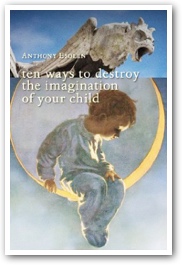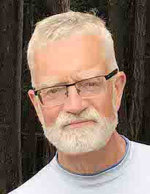A review of Ten Ways to Destroy the Imagination of Your Child
- THOMAS HOWARD
Here is a book that will send a reviewer — and all decent-minded readers — groping for superlatives.
 |
Indeed, I find it difficult to refrain from cluttering my review with mere rhapsodies, which might be warranted, but which do not throw much light on things.
Anthony Esolen mounts a crushing and delightful riposte to the whole array of theories on the rearing and education of children that preside in current American culture. Ironically, however, the note he strikes, far from sounding the sullen tone often marking the work of those who (justly) find themselves appalled at those doctrines, is joyous. Sprightly, lucid, exultant: such words touch on the spirit of the book.
Early on we find a crucial distinction between, on the one hand, the modern notion that what the child needs above all is to be set free from the iron grid of dull memory work (dates and names, etc.), so that he is free to float in the ether of free-wheeling "creativity," and, on the other hand, the ancient notion that memory places a child within a lineage in which he is a very recent arrival. The latter approach helps the child to avoid the trap of hubris. Esolen marshals everything from Icelandic sagas to Ray's New Higher Arithmetic (1880) to demonstrate this point. The tedious burden of numbers and facts and dates (says modernity) can quell a child's creative spontaneity. Esolen responds by extolling the numbers and the facts. He suspects with good reason that an untutored "creativity" most often lures a child into the fen of mere banality and solipsism.
At this point Esolen considers the modern anxiety that hovers like a nanny over children's education. He suggests waggishly that one tactic for protecting your child from the threat of brittle and demanding reality might be, then, to keep your child indoors, since outdoors, what with its winds and waves and woods and loam and curious little paths, with the vast sky flung overhead like an azure canopy, might vitiate his conviction that he is the center of everything. Don't let your child discover the psalmist: "When I consider the heavens, the work of thy fingers, the moon and the stars which Thou hast ordained . . ." or G. M. Hopkins's "What wind walks! What lovely behaviour / Of silk-sack clouds. . . ." The danger here is that your child might be beckoned out into That-Which-Is-Bigger-than-He, thus planting in his mind the humbling idea that all of this immensity exists quite apart from whether it pleases him, or is convenient.
The next theory (or "Method Two," in Esolen's litany of the tactics proposed by contemporary educational canons) warns us against allowing a child to play unsupervised games of his own devising. The great thing is to ensure that he is "socialized into a managed world." Over against the old spontaneous world of Hide and Seek, Red Rover, Cops and Robbers, Jump Rope, or Leap Frog, all of which seemed to have sprung any-old-how from the rough-hewn nature of childhood itself, linking children with centuries of play, we now find the great pall of Planning, issuing from the ponderous and shadowy committees who "know" what children need.
In this connection we find Esolen unexpectedly putting the case in favor of machines. Machinery is dangerous, say the experts: safety, safety, safety, at all costs. We might, in such a book, have expected the usual jeremiad decrying the rattle and filth of the Machine Age. But Esolen is no Luddite. He reminds us that machinery is a Good Thing: refrigerators ("ice-boxes," they once were called) obviated the whole business of sawing ice and hauling it from ponds; washing machines lightened the backbreaking work of washboards. He points out the fascination of backhoes and pile drivers which invite a child to ponder such contraptions, thus saving Esolen's argument from being a mere encomium to The Past.
Ten Ways to Destroy the Imagination of Your Child
by Anthony Esolen |
The old, unedited fairy tales and folk tales, which opened out onto a totally unregulated domain, patently dangerous for a child's emotional health, simply won't do. We can't have the wolf gobbling up granny, or Cinderella's sisters having their eyes pecked out by helpful little birds. All too gruesome the modern theory being that the child must never be asked to cope with the gruesome. I must confess that I myself might wish to tax Esolen on this point amiably, to be sure. But his point is that those old tales, at times gruesome, roused a child's imagination. They saw life in all of its peremptory starkness. They never applauded the gruesome. Furthermore, the figures that showed up in those stories were patently good or evil. Esolen remarks here, "It has been a great victory for the crushers of imagination to label such figures 'stereotypes,' and add a sneer to it, as if people who used them in their stories were not very imaginative." Current educational theories, with the moral vision that suffuses them, suppose that at all costs everything must be nuanced. Since there are no eternal fixities anyway, we can never presume to judge people whether thieves or cruel stepmothers. Esolen's rejoinder here is that in the realm of faerie we do, in fact, come up against intransigent figures or better, archetypes: orcs, Dark Riders, dragons, wicked stepmothers. That's what the genre is about. It is in other genres of literature serious drama, or post-eighteenth-century prose fiction, say that we undertake the nuanced psychological scrutiny of human behavior.
Speaking of the (praiseworthy) case of traditional romance novels, we find this: "Some years ago, the romance novels were populated by women dying to swoon into the arms of Dangerous but Gentle Men, who only needed a Loyal Woman to bring them back into Decent Society. Now what they need is a Strong Woman, a Lady Lawyer, or an Adventuring Careerist the cliches will shift from decade to decade, but the fullness will remain. Remember to foster banality."
If we were to forge straight on through Esolen's swashbuckling (but wholly fair) assault on modern theories of child-rearing, this review could run to insupportable length. We have so far canvassed only four of the ten aspects in Esolen's critique. Heroes and patriots what about them? Who is the "hero" now? Sex: what has become of Odysseus's shy and exquisitely delicate ode to Nausicaä, whom he might have seized and ravished on the spot if he had been weaned on contemporary cinema? Or the Scot William Douglas's musings on Annie Laurie: "Her brow is like the snaw-drift, / Her neck is like the swan, / . . . And dark blue is her e'e, / And for bonnie Annie Laurie / I'd lay me doon and dee." Or gender: could Milton have gotten away nowadays with his unabashed extolling of Adam's delicate plea to Eve, who, in demure and maidenly hesitancy, has fled from the approach of the Masculine? Or Sigrid Unset: surely editors now would have incredulously blue-penciled these lines: "The child grew red with pleasure, for she knew well that her father was held to be the comeliest man far around; he looked like a knight, standing there among his men." Fie.
This book, in my opinion, qualifies for the New Yorker's category, "Of More Than Routine Interest." Far more. The work is remorselessly perspicacious, prophetic, serious, amusing, and vastly refreshing.
 This is J. Fraser Field, Founder of CERC. I hope you appreciated this piece. We curate these articles especially for believers like you.
This is J. Fraser Field, Founder of CERC. I hope you appreciated this piece. We curate these articles especially for believers like you.
Please show your appreciation by making a $3 donation. CERC is entirely reader supported.

Acknowledgement
 Thomas Howard. "Avoiding the Fen of Banality and Solipsism, A review of Ten Ways to Destroy the Imagination of Your Child." The Intercollegiate Review (Fall 2011).
Thomas Howard. "Avoiding the Fen of Banality and Solipsism, A review of Ten Ways to Destroy the Imagination of Your Child." The Intercollegiate Review (Fall 2011).
Reprinted with permission of ISI and The Intercollegiate Review.
The Author
 Thomas Howard taught for many years at St. John's Seminary College, the Roman Catholic seminary of the archdiocese of Boston. He became Episcopalian in his mid-twenties, then entered the Catholic Church in 1985. Among the books he has authored are Chance or the Dance?, The Night Is Far Spent, Evangelical is Not Enough, If Your Mind Wanders at Mass, On Being Catholic, Dove Descending: A Journey Into T.S. Eliot's Four Quartets, and The Secret of New York Revealed. Howard's story of why he became Catholic is called Lead, Kindly Light: My Journey to Rome.
Thomas Howard taught for many years at St. John's Seminary College, the Roman Catholic seminary of the archdiocese of Boston. He became Episcopalian in his mid-twenties, then entered the Catholic Church in 1985. Among the books he has authored are Chance or the Dance?, The Night Is Far Spent, Evangelical is Not Enough, If Your Mind Wanders at Mass, On Being Catholic, Dove Descending: A Journey Into T.S. Eliot's Four Quartets, and The Secret of New York Revealed. Howard's story of why he became Catholic is called Lead, Kindly Light: My Journey to Rome.



